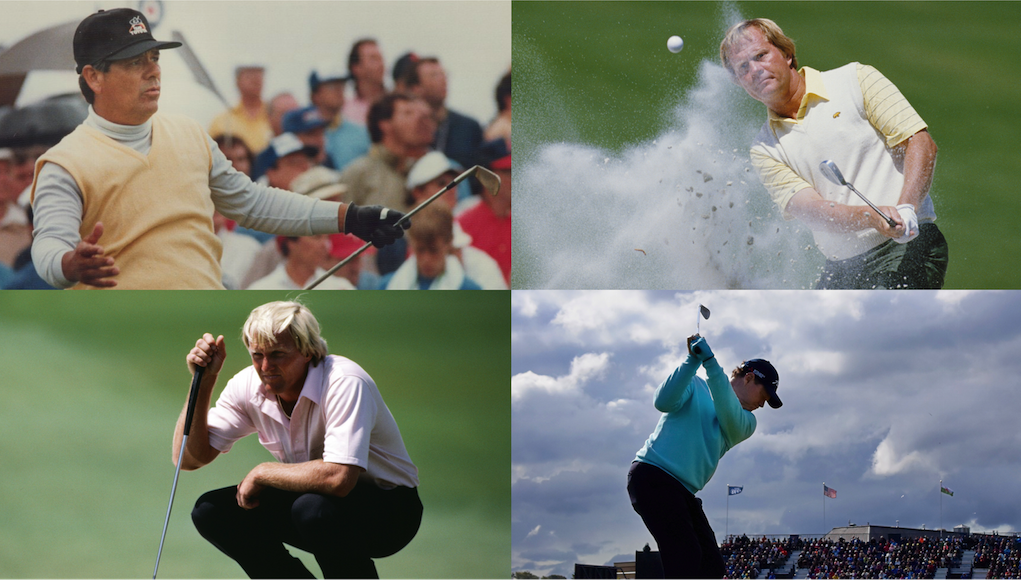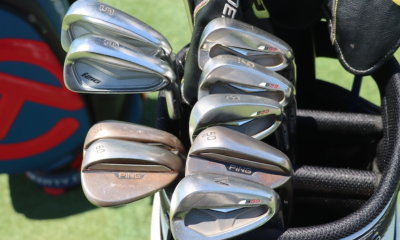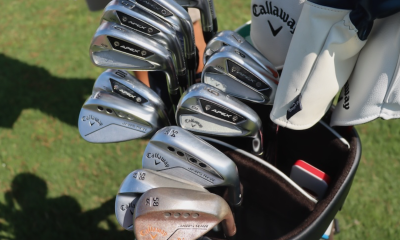Instruction
No Golfer Has a Full Bag of Clubs

If you’re like me, you love to read anything and everything written about golf in hopes of picking up a little tidbit here or there that could help your game. But one article stands out from any other that I’ve ever read. It discussed top golfers and their weaknesses, and was written by Lee Trevino and Golf Digest sometime in the early-to-mid 1980s.
Lee said no golfer “has a full bag of clubs,” and because of this even the best players in the world have to work around the weak links in their game. It’s been a long time, but allow me to try and recap the article as I remember it.
- Lee Trevino: Couldn’t hit his long irons, thus Augusta was his nemesis.
- Jack Nicklaus: Couldn’t hit wedges around the greens.
- Tom Watson: Couldn’t dial back his golf swing when necessary.
- Greg Norman: Didn’t know when to hit to the center of the green.
Obviously these are generalizations, and you could certainly make similar observations about the top players in today’s game. The point is that there’s no such thing as a perfect golfer, so we all must work around issues within our game regardless of our skill level.
Fortunately, there are many new tools that can help the golfers of today improve: high-tech club designs, mental-game gurus, launch monitors and player-performance coaches, to name a few. The key is for you as the player to be 100 percent open and honest about your weaknesses.
As with anything, it is MUCH easier to put energy into the things you like than what you don’t particularly enjoy — take exercising and eating right, for example. But if you want to be a complete golfer, or as complete as you can be, then you must attack your weak links.
I suggest each of you begin the new golf season by speaking with your home professional and play a round of golf with him or her. Ask for critical feedback so together you can formulate a plan of attack moving forward.
Sounds simple, right?
You’d be surprised how many players do NOT want to know what they’re doing wrong or not doing very well. The truth will set you free, though, and maybe even add a few more “clubs” to your bag.
Think about it: What is currently the glaring weakness in your golf game? What can you do this season to improve it?
- LIKE146
- LEGIT16
- WOW4
- LOL8
- IDHT2
- FLOP2
- OB0
- SHANK53
Instruction
Clement: Laid-off or perfect fade? Across-the-line or perfect draw?

Some call the image on the left laid off, but if you are hitting a fade, this could be a perfect backswing for it! Same for across the line for a draw! Stop racking your brain with perceived mistakes and simply match backswing to shot shape!
- LIKE0
- LEGIT0
- WOW0
- LOL0
- IDHT0
- FLOP0
- OB0
- SHANK1
Instruction
The Wedge Guy: The easiest-to-learn golf basic

My golf learning began with this simple fact – if you don’t have a fundamentally sound hold on the golf club, it is practically impossible for your body to execute a fundamentally sound golf swing. I’m still a big believer that the golf swing is much easier to execute if you begin with the proper hold on the club.
As you might imagine, I come into contact with hundreds of golfers of all skill levels. And it is very rare to see a good player with a bad hold on the golf club. There are some exceptions, for sure, but they are very few and very far between, and they typically have beat so many balls with their poor grip that they’ve found a way to work around it.
The reality of biophysics is that the body moves only in certain ways – and the particulars of the way you hold the golf club can totally prevent a sound swing motion that allows the club to release properly through the impact zone. The wonderful thing is that anyone can learn how to put a fundamentally sound hold on the golf club, and you can practice it anywhere your hands are not otherwise engaged, like watching TV or just sitting and relaxing.
Whether you prefer an overlap, interlock or full-finger (not baseball!) grip on the club, the same fundamentals apply. Here are the major grip faults I see most often, in the order of the frequency:
Mis-aligned hands
By this I mean that the palms of the two hands are not parallel to each other. Too many golfers have a weak left hand and strong right, or vice versa. The easiest way to learn how to hold the club with your palms aligned properly is to grip a plain wooden ruler or yardstick. It forces the hands to align properly and shows you how that feels. If you grip and re-grip a yardstick several times, then grip a club, you’ll see that the learning curve is almost immediate.
The position of the grip in the upper/left hand
I also observe many golfers who have the butt of the grip too far into the heel pad of the upper hand (the left hand for right-handed players). It’s amazing how much easier it is to release the club through the ball if even 1/4-1/2″ of the butt is beyond the left heel pad. Try this yourself to see what I mean. Swing the club freely with just your left hand and notice the difference in its release from when you hold it at the end of the grip, versus gripping down even a half inch.
To help you really understand how this works, go to the range and hit shots with your five-iron gripped down a full inch to make the club the same length as your seven-iron. You will probably see an amazing shot shape difference, and likely not see as much distance loss as you would expect.
Too much lower (right) hand on the club
It seems like almost all golfers of 8-10 handicap or higher have the club too far into the palm of the lower hand, because that feels “good” if you are trying to control the path of the clubhead to the ball. But the golf swing is not an effort to hit at the ball – it is a swing of the club. The proper hold on the club has the grip underneath the pad at the base of the fingers. This will likely feel “weak” to you — like you cannot control the club like that. EXACTLY. You should not be trying to control the club with your lower/master hand.
Gripping too tightly
Nearly all golfers hold the club too tightly, which tenses up the forearms and prevents a proper release of the club through impact. In order for the club to move back and through properly, you must feel that the club is controlled by the last three fingers of the upper hand, and the middle two fingers of the lower hand. If you engage your thumbs and forefingers in “holding” the club, the result will almost always be a grip that is too tight. Try this for yourself. Hold the club in your upper hand only, and squeeze firmly with just the last three fingers, with the forefinger and thumb off the club entirely. You have good control, but your forearms are not tense. Then begin to squeeze down with your thumb and forefinger and observe the tensing of the entire forearm. This is the way we are made, so the key to preventing tenseness in the arms is to hold the club very lightly with the “pinchers” — the thumbs and forefingers.
So, those are what I believe are the four fundamentals of a good grip. Anyone can learn them in their home or office very quickly. There is no easier way to improve your ball striking consistency and add distance than giving more attention to the way you hold the golf club.
More from the Wedge Guy
- The Wedge Guy: Golf mastery begins with your wedge game
- The Wedge Guy: Why golf is 20 times harder than brain surgery
- The Wedge Guy: Musings on the golf ball rollback
- LIKE88
- LEGIT14
- WOW6
- LOL1
- IDHT0
- FLOP4
- OB1
- SHANK8
Instruction
Clement: Stop ripping off your swing with this drill!

Not the dreaded headcover under the armpit drill! As if your body is defective and can’t function by itself! Have you seen how incredible the human machine is with all the incredible feats of agility all kinds of athletes are accomplishing? You think your body is so defective (the good Lord is laughing his head off at you) that it needs a headcover tucked under the armpit so you can swing like T-Rex?
- LIKE0
- LEGIT2
- WOW2
- LOL0
- IDHT0
- FLOP0
- OB0
- SHANK2
-

 19th Hole3 weeks ago
19th Hole3 weeks agoDave Portnoy places monstrous outright bet for the 2024 Masters
-

 19th Hole1 week ago
19th Hole1 week agoJustin Thomas on the equipment choice of Scottie Scheffler that he thinks is ‘weird’
-

 19th Hole1 week ago
19th Hole1 week ago‘Absolutely crazy’ – Major champ lays into Patrick Cantlay over his decision on final hole of RBC Heritage
-

 19th Hole2 weeks ago
19th Hole2 weeks agoTwo star names reportedly blanked Jon Rahm all week at the Masters
-

 19th Hole2 weeks ago
19th Hole2 weeks agoReport: LIV Golf identifies latest star name they hope to sign to breakaway tour
-

 19th Hole2 weeks ago
19th Hole2 weeks agoNeal Shipley presser ends in awkward fashion after reporter claims Tiger handed him note on 8th fairway
-

 19th Hole2 weeks ago
19th Hole2 weeks agoBrandel Chamblee has ‘no doubt’ who started the McIlroy/LIV rumor and why
-

 Equipment3 weeks ago
Equipment3 weeks agoWhat we know about Bryson DeChambeau’s 3D-printed Avoda irons

















ivor robson
Feb 4, 2017 at 11:18 pm
Yes definitely the todger
miuralovechild
Feb 4, 2017 at 9:26 pm
Tiger’s biggest weakness IMO was that couldn’t keep his junk in his pants. It cost him a few majors post 2008.
Cameron
Feb 3, 2017 at 9:19 pm
Whats everyones opinion of what tigers weak area was in his prime?
Johnnylongballz
Feb 6, 2017 at 6:57 am
That is an easy one. Tiger has always struggled with the driver. He could hit one incredible drive 350 down the middle, and then hit the next off the planet.
Bob Jones
Feb 3, 2017 at 10:59 am
Sam Snead made the same observation once. He said some golfers are good with the longer clubs and others are good with the shorter clubs, but no one is good throughout the bag.
Geoffrey Holland
Feb 3, 2017 at 9:02 am
Jack did a lot of work with Phil Rodgers in the late seventies to the early eighties to get his short game better. He gave him a lot of credit for his two majors in 1980.
Rodgers was the short game guru for a time. Rodgers may be best known for losing the 1963 Open Championship to Bob Charles in a 36 hole playoff.
Double Mocha Man
Feb 3, 2017 at 10:13 am
Why do you have to be named Phil to have a good short game? I’m changing my name.
Greg Hunte
Feb 3, 2017 at 10:00 pm
That’s a good one!
Double Mocha Man
Feb 2, 2017 at 6:24 pm
The headline made me think nobody on tour could count to 14.
Seb
Feb 2, 2017 at 2:34 pm
I like this. Good read
Smelly
Feb 2, 2017 at 1:05 pm
I have to speak to myself first before I speak to a professional lmao
Steven
Feb 2, 2017 at 12:45 pm
Good article. Right on point and illustrates 2 distinct problems. The first is a psychology problem. Most people like to be affirmed and feel good, so we all tend to continue to practice the thing we do well. Failing at a task and trying to improve over time doesn’t provide instant gratification, so many people don’t focus on weak areas. That creates a cycle of never getting better at a task. The second problem is more strategy. Many of us know our weakness but don’t play around it. If chipping it close is difficult and a golfer’s miss is generally to the right, then they shouldn’t aim at a tightly tucked pin to the right. However, many amateurs take dead aim at every pin and the misses cause more problems. Most of us should aim at the center of the green or slightly favor the side we generally don’t miss on.
TR1PTIK
Feb 2, 2017 at 12:44 pm
IMO mental state and ability are clubs in the bag as much as the real sticks. You have to develop the areas of weakness if you want to get better. I love the suggestion about playing with a teaching professional because it really does open some new opportunities for improvement. I had a couple lessons last season where all the pro did was talk to me about what my swing is doing – nothing about how to correct, but simply what it does and cause & effect. That immediately changed the way I approached certain shots and I saw a sharp decrease in scoring when I got it right.
chinchbugs
Feb 2, 2017 at 12:13 pm
None of these guys are even currently ranked in the top 1000 in the OWGR so who cares!
😛
Barry
Feb 2, 2017 at 11:04 am
Jack Nicklaus: Couldn’t hit wedges around the greens
Oh really??
Prime21
Feb 2, 2017 at 11:26 am
True. Statistically Jack’s pitching & bunker play was the weakest part of his game. This is an indisputable fact that even he has admitted to on more than 1 occasion. 1 of the reasons he favored the center of the green & rarely short sided himself. What about Lee’s honest assessment is so startling? That 1 of the greatest ever had a weakness & learned to play away from it? Seems like this excercise could really help you, if you’re willing to be honest, that is.
Tiemco
Feb 2, 2017 at 11:34 am
Yes, as great as Jack was his weakness was chipping around the greens. This was probably due to the fact that he was usually on in regulation and never felt the need to practice that aspect of his game. Sure he was competent at greenside chipping but he was not a master of it.
Tom
Feb 2, 2017 at 9:16 am
I’d say not knowing when to hit the center of the green is more of a mental issue than anything, but I agree with the article.
Especially in the case of Amateurs.. You go to the range and see a guy hit 30 sand wedges, 20 pitching wedges, some 7i’s, mis hits his 6i a few times, goes to the driver or puts the ball on a tee for a fairway wood.
Wonderful.. You’ve hit your driver enough times to know your miss and you swing and pray. You’re adequate with a 8i to sand wedge, and when you’re 185 out from a green, you have absolutely no hope, besides exhibit A: of swinging and praying, again. I was as guilty of this as anyone for a long time. Granted my 5i was one of my favorite clubs to hit, but I may as well have not even bagged a 4i.
Now I hit my 3i more than any other club when practicing, and it has made every other club easier to hit. I get you don’t want to look like a bad golfer at the range, but you’re not going to get any better if you don’t even know what good contact feels like with a long iron, because you’ve never practiced it. I’d say a fairway wood off the deck is the 2nd least hit shot on any range I’ve been to, and then people complain.. lol. We will always have our weak points, but working on those is better than continuing to strengthen a small array of simple shots you already know how to hit.
TR1PTIK
Feb 2, 2017 at 12:37 pm
I always spend at least a little time with the most difficult club in my bag. If can flush it a couple times, I know I’m doing good. If not, then I need to grab another bucket.
Double Mocha Man
Feb 2, 2017 at 1:04 pm
I play to a sub 3 handicap. But when I’m on the range I look like a 20 handicapper. Because I’m trying out new things, tweaking, learning, sacrificing a well-struck shot for one that might pay dividends in the future. That’s why I like to find a quiet spot at the end of the range where nobody’s looking.
Shortside
Mar 1, 2017 at 1:13 pm
I do the same often. Practicing a worm burning 3 metal and a variety of other awkward looking shots doesn’t too look impressive on the range. But they’re very handy shots for those of us that visit the woods from time to time. Most “recreational” players never practice trouble shots.
Mikee
Feb 2, 2017 at 8:15 am
Well said Tom….most of us over exaggerate our abilities….or as one of my friends says…..delusions of adequacy!